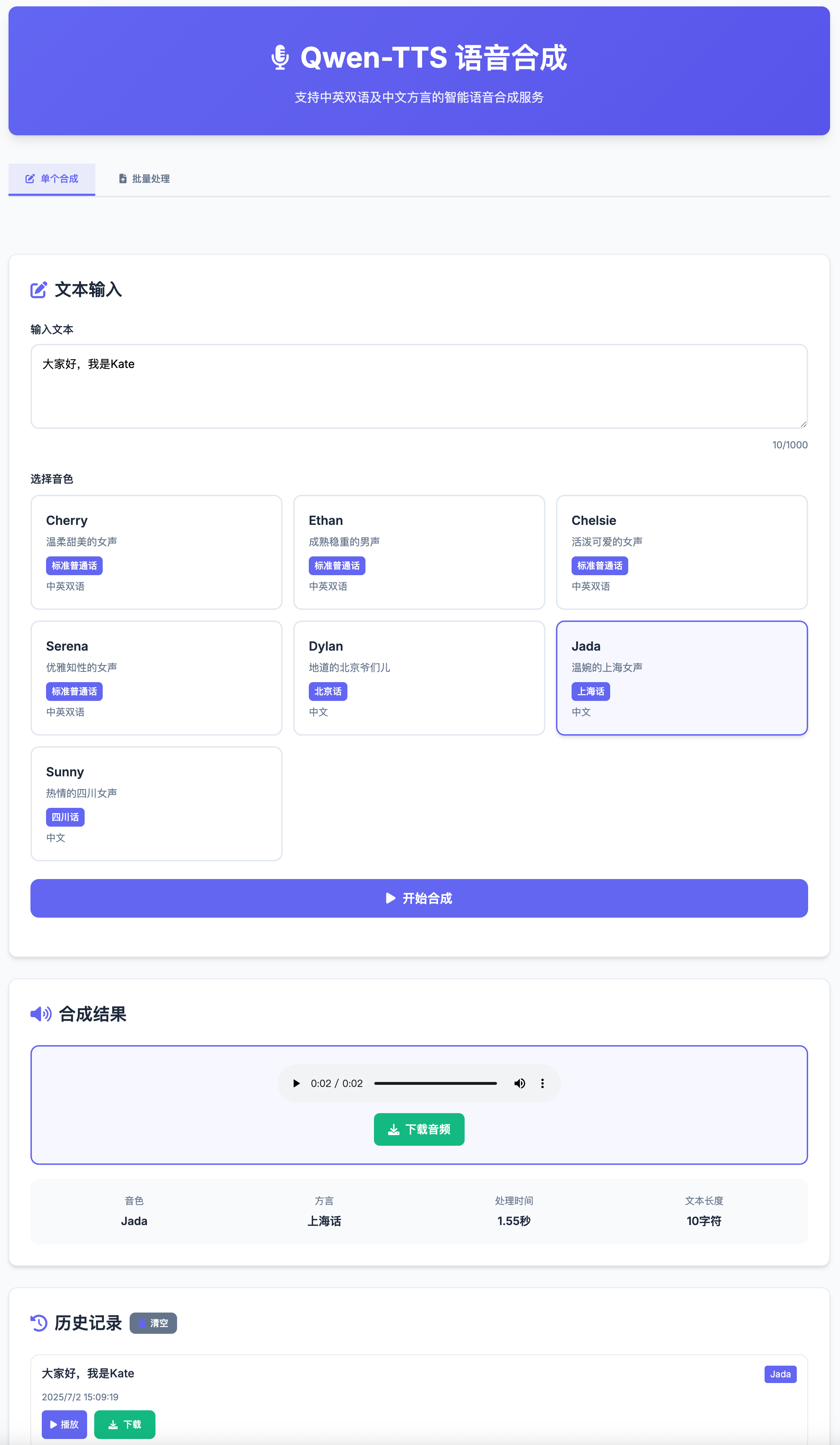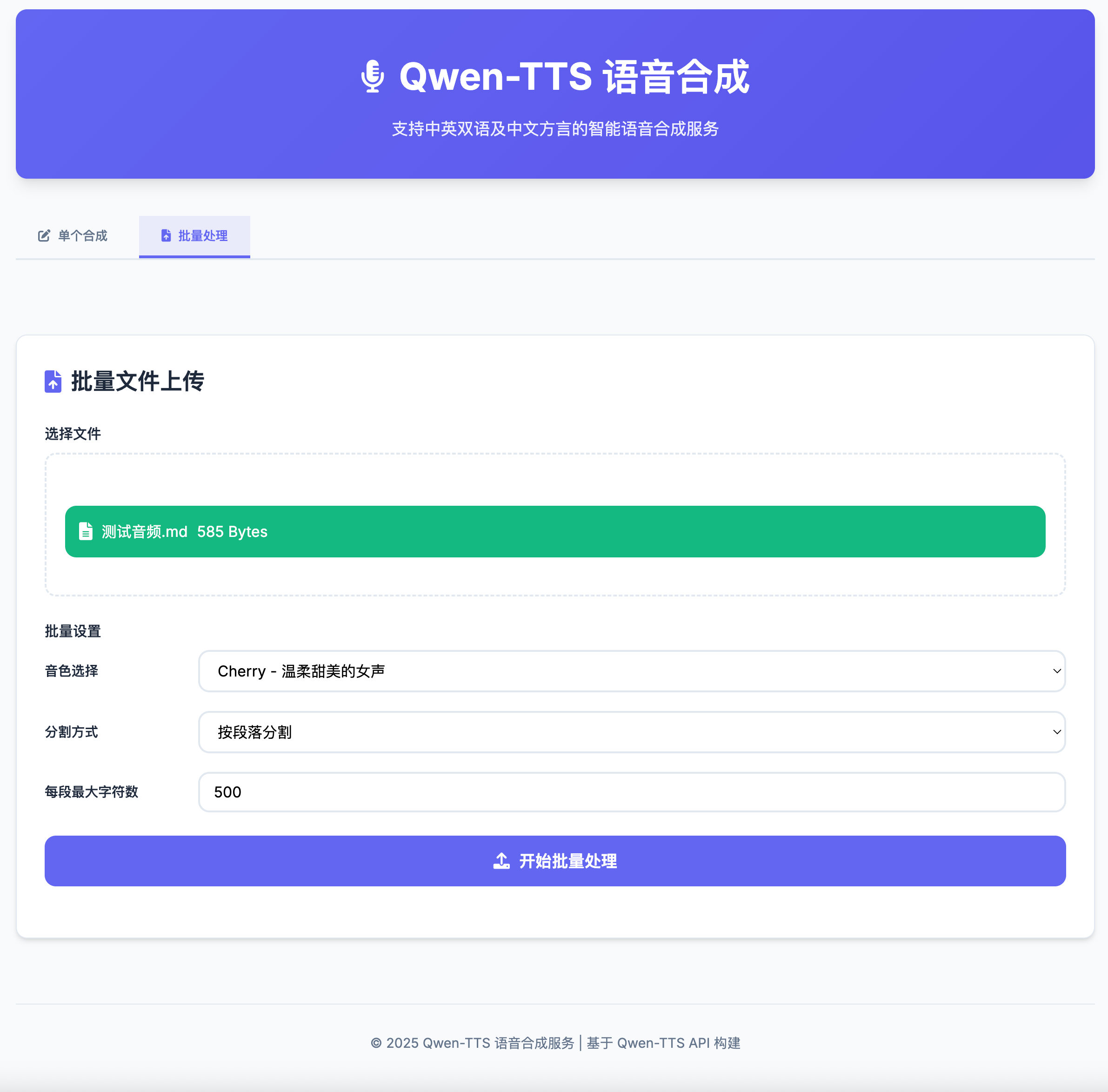qwen-tts
 qwen-tts copied to clipboard
qwen-tts copied to clipboard
Qwen-TTS offers a robust voice synthesis service using FastAPI, supporting bilingual and dialect options. Explore seamless audio generation on GitHub! 🚀🌟
Qwen-TTS: A Versatile Text-to-Speech Service
Overview
Welcome to the Qwen-TTS repository. This project offers a powerful text-to-speech service built on the Qwen-TTS API. It supports both Chinese and English, along with various Chinese dialects. This FastAPI application aims to provide a seamless experience for users needing voice synthesis capabilities.
📸 Interface Preview
Single Synthesis Interface

Batch Processing Interface

✨ Features
🎯 Core Features
- Multi-Voice Support: Choose from 7 different voices, including options for both Chinese and English.
- Dialect Support: Includes Beijing, Shanghai, and Sichuan dialects.
- Real-Time Synthesis: Experience fast and responsive voice synthesis.
- Batch Processing: Upload and process txt/md files in bulk.
- Smart Segmentation: Automatically split text by paragraphs, sentences, or chapters.
- Progress Tracking: Monitor batch processing progress in real time.
- Audio Playback: Play and download audio directly from the interface.
- Audio Format: Outputs in WAV format for clear sound quality.
🎨 Interface Features
- Modern Design: A visually appealing and responsive user interface.
- Consistent Layout: Unified width (1200px) for both single synthesis and batch processing pages.
- Intuitive Operation: User-friendly experience for all users.
- History Tracking: Automatically saves synthesis history for easy access.
- Real-Time Feedback: Character count and status updates displayed live.
🔧 Technical Features
- Asynchronous Processing: High-performance asynchronous API for quick responses.
- Error Handling: Comprehensive error management to ensure smooth operation.
- File Management: Automatic management of audio files for convenience.
- API Documentation: Complete OpenAPI documentation available for developers.
🎤 Supported Voices
| Voice | Language | Description | Dialect |
|---|---|---|---|
| Cherry | Chinese/English | Gentle and sweet female voice | Standard Mandarin |
| Ethan | Chinese/English | Mature and steady male voice | Standard Mandarin |
| Chelsie | Chinese/English | Lively and cute female voice | Standard Mandarin |
| Serena | Chinese/English | Elegant and knowledgeable female voice | Standard Mandarin |
| Dylan | Chinese | Authentic Beijing male voice | Beijing dialect |
| Jada | Chinese | Gentle Shanghai female voice | Shanghai dialect |
| Sunny | Chinese | Enthusiastic Sichuan female voice | Sichuan dialect |
🚀 Quick Start
To get started with Qwen-TTS, follow these steps:
- Download the Latest Release: Visit the Releases section to download the latest version of the application.
- Installation: Follow the installation instructions provided in the release notes.
- Run the Application: Execute the application to start using the text-to-speech features.
For detailed instructions, refer to the documentation provided in the repository.
📦 Installation
Requirements
- Python 3.8 or higher
- FastAPI
- Uvicorn
- Additional dependencies as listed in
requirements.txt
Installation Steps
- Clone the repository:
git clone https://github.com/mco2004/qwen-tts.git cd qwen-tts - Install the required packages:
pip install -r requirements.txt - Run the application:
uvicorn main:app --reload
Configuration
You may need to configure certain parameters in a configuration file or environment variables. Check the repository for more details.
🌐 API Endpoints
The Qwen-TTS API provides several endpoints for text-to-speech operations. Below are the main endpoints available:
1. Single Synthesis
- Endpoint:
/synthesize - Method: POST
- Description: Synthesize speech from a single text input.
2. Batch Processing
- Endpoint:
/batch - Method: POST
- Description: Upload a file containing multiple texts for batch synthesis.
3. Voice List
- Endpoint:
/voices - Method: GET
- Description: Retrieve a list of available voices and their details.
Refer to the API documentation for more information on request and response formats.
🔍 Usage Examples
Single Synthesis Example
To synthesize speech from a single text input, send a POST request to the /synthesize endpoint with the following JSON body:
{
"text": "你好,欢迎使用 Qwen-TTS!",
"voice": "Cherry"
}
Batch Processing Example
To process multiple texts, upload a file to the /batch endpoint. The file should contain one text per line.
📄 Documentation
Comprehensive API documentation is available in the repository. This includes detailed descriptions of each endpoint, request/response formats, and examples.
🔗 Links
- For the latest releases, visit the Releases section.
- Check the Wiki for more in-depth tutorials and guides.
🛠️ Contribution
We welcome contributions to improve Qwen-TTS. If you would like to contribute, please fork the repository and submit a pull request. Ensure that you follow the coding standards and include tests for new features.
📬 Contact
For questions or feedback, please open an issue in the repository. You can also reach out via email or other contact methods listed in the repository.
🎉 Acknowledgments
Thank you to all contributors and users who support the development of Qwen-TTS. Your feedback helps us improve the application and provide better services.
Explore the capabilities of Qwen-TTS and enhance your projects with advanced text-to-speech functionalities.